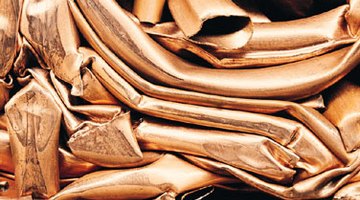How to Passivate Copper
Passivation refers to the treatment of some metals with chemical baths that makes them permanently immune to corrosion. Passivation also can refer to the application of anti-corrosives. Copper is one metal that cannot truly be altered through passivation.

Things You Will Need
- Ammonium sulfate
- Copper sulfate
- Ammonia
However, through both natural and chemical means, copper can be made resistant to corrosion.
-
Expose copper to the elements. Although it is a gradual process that varies in speed depending upon the humidity and heat in the environment, baring copper to the outdoors is the simplest way to passivate it. Within four to eight weeks, a dull blue-green patina will form on the copper. This patina is a corrosion inhibitor.
-
Accelerate the growth of the patina with a chemical bath of ammonium sulfate, 6 pounds; copper sulfate, 3 ounces; ammonia, 1.34 fluid ounces, and water, 6.5 gallons.
-
Apply the mixture as a spray. Allow it to dry between six applications. Wait six hours to see the patina deepen in color. Growth of the patina film will now spread faster.
Tip
Should the ingredients for the chemical bath not be available to you, adding three grams of benzotriazole to a liter of water will produce a similar effect.
Warning
Wearing rubber gloves and safety goggles can protect hands and eyes from harsh chemicals.
References
- "Machinery's Handbook Toolbox Edition: 28th Edition;" Erik Oberq; Industrial Press, 2008
- Finishing: Passivated Copper
- Stellar Solutions: What is Passivation
Writer Bio
Bjorck DiMarco has been the Senior Editor at an independent publishing house since 1994. She holds advanced degrees in teaching, English and creative writing, graduating summa cum laude from Tufts University and the University of Massachusetts. DiMarco has also worked in construction, fine woodworking, graphic design and theoretical mathematics.
Photo Credits
- Stockbyte/Stockbyte/Getty Images
- Stockbyte/Stockbyte/Getty Images
More Articles



